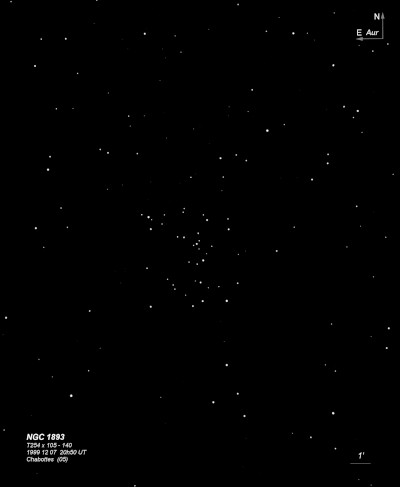
John Herschel discovered NGC 1893 = h351 on 22 Jan 1827 (sweep 51) and described a "rich coarse cluster of scattered stars 9...15m; more than fills field." There is nothing at his position but exactly 3 tmin of RA west is a cluster embedded in the HII region IC 410. JH didn't mention any nebulosity in his description, so the number should just apply to the cluster only, with IC 410 referring to the nebula. The error in position was copied by JH into the GC and by Dreyer into the NGC. In the 1926 photographic survey "Die Herschel-Nebel", Karl Reinmuth gave an corrected RA (noting it with an asterisk).
300/350mm - 13.1" (2/25/84): about 40 mostly faint stars, elongated N-S in poor transparency. Located within a triangle of three mag 8 stars. The emission nebula IC 410 is involved.
600/800mm - 24" (1/4/14): at 200x, this bright, young cluster contains 80-100 stars, with the richest portion forming a large boomerang-shaped region extending 12'x5' N-S. The outline is slightly concave to the west and convex to the east with a narrow denser region in the center with several pairs and trios. NGC 1893 is the core of the Aur OB2 association and contains a number of massive O-type stars including 9th mag O4-type HD 242908 at the NW tip of the "boomerang" and 9.4-mag HD 24296 (O6-type star) forming the SW tip of the outline. In the rich central region is 9.8-mag O7-type HD 242935, and the brightest component of the multiple star Bu 887, with two fainter companions at ~10" separation. Just 1.4' NNW of this triple is a 14" of mag 10.4/11.4 stars, with brighter component BD+33 1025, an O8-type star. Also 2.4' SE is a 10" pair of mag 11.4/12.4 stars. In addition, many other stars appear to be arranged in pairs and strings, so the cluster has a striking appearance. These and other hot O and B-type stars in the cluster ionize the large emission nebula IC 410, which is quite impressive using a UHC filter (see separate description).
The cometary "Tadpoles" nebulae Simeis 130 and 129, which contain recently minted stars, lie on the east end of the cluster. The "head" of Simeis 130 was immediately picked up at 200x as a very small, fairly high surface brightness knot with at least one star involved. At 260x and 375, two very close "stars" oriented WSW-ENE were embedded in the glow, with the ENE object quasi-stellar (would not focus to a sharp point) and perhaps a very tight pair. Although impressive on images, there was no sign of the wavy tail extending from the "head" towards the NE. Mag 9.1 BD+33 1028, 3' E of Simeis 130, along with a 6' group of a half-dozen mag 10-11 stars, were visually detached to the NE of the main cluster.
900/1200mm - 48" (10/27/19): just west of the cluster was a noticeable dark nebula, ~3' in diameter and it provided a striking contrast with the rich cluster immediately to its east and northeast.
Notes by Steve Gottlieb